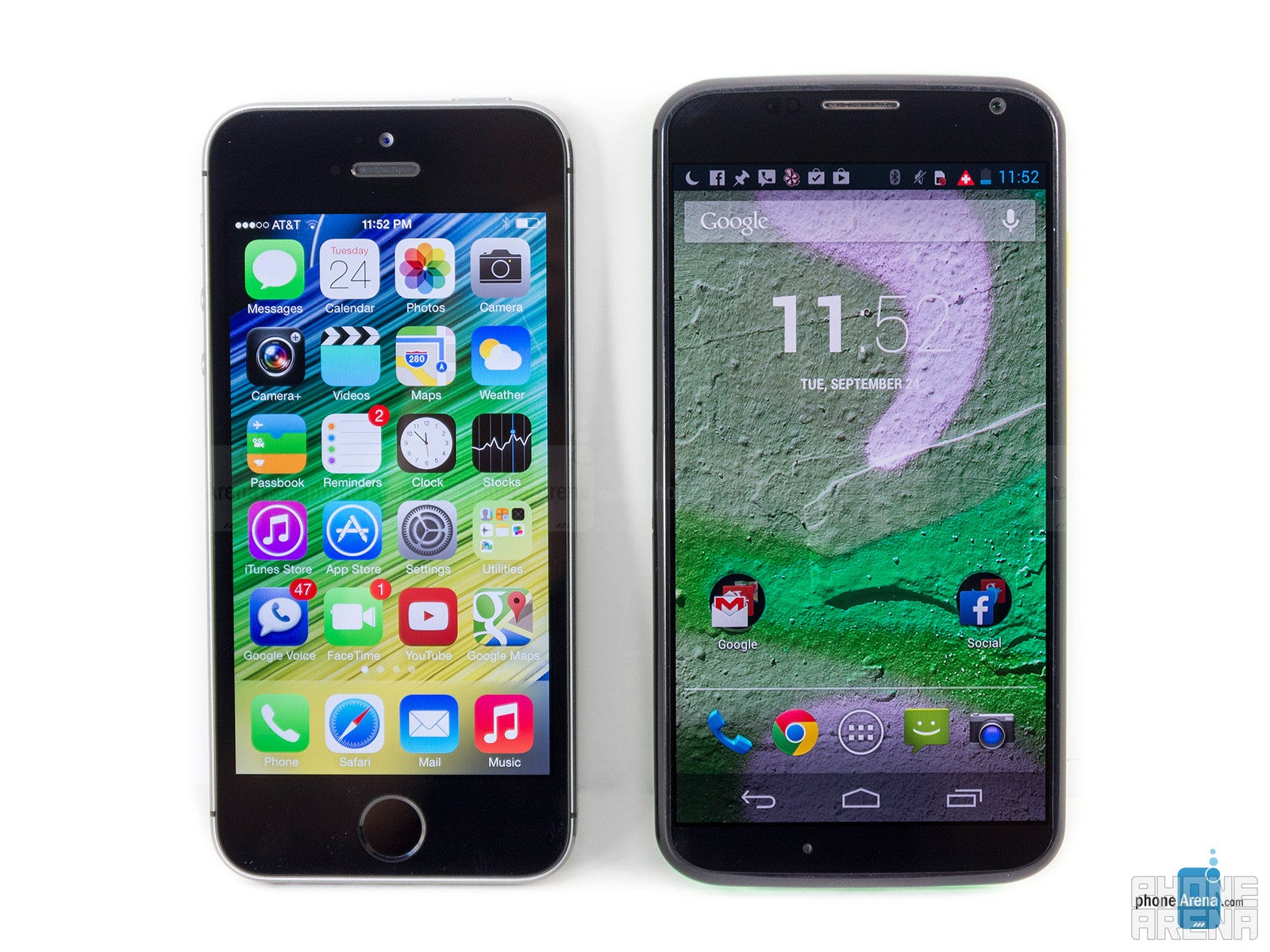Apple iPhone 5s vs Motorola Moto X
Introduction

Design
Let’s cut to the chase folks! The customizable aspect of the Moto X’s design is undoubtedly something that helps to make it more intriguing than the iPhone 5s, especially when Apple’s prodigy has a recycled design. In fact, we’re astounded by the level of control and personalization that the Moto X brings to the table, giving certain customers (AT&T to be exact right now) the ability to select different patterns and colors to make each phone unique. In comparison, the iPhone 5s sports the more premium design between the two, which is attributed to its brushed aluminum casing and sturdy construction. As a whole, though, there’s nothing new with its design – except for its new color options.
Even though the two are comparatively sized, making them very easy to grasp with a single hand, there’s more of a natural feel with the Moto X – thanks partly to its curved rear casing. Our hands still take a liking to the iPhone 5s too, but its chamfered edges feel sharp. Moreover, we’re totally impressed by how closely the Moto X matches the iPhone 5s’ size, even more when it’s packing a larger display.
With its diverse color combinations combined with its ergonomic design, we find the Moto X to have the more interesting design – easily catching the attention of any bystander.
Looking around the sides of both phones, they pretty much boast the same set of buttons of ports. However, we actually prefer the power and volume controls on the iPhone 5s, mainly because they’re larger and more distinctive to the touch.
Display

Relying on different display technologies, IPS LCD for the iPhone 5s and AMOLED with the Moto X, they have their unique characteristics that make them stand out. For starters, we get those typical saturated colors with the AMOLED display of the Moto X, as well as its wide viewing angles and deep black color, but the iPhone 5s’ IPS LCD display offers the more realistic colors and superior outdoor visibility.
Ultimately though, it’s a matter of what actually pleases your eyes more. Some will vouch for the punchy and glowing color tones of the Moto X’s display, while others prefer the superior outdoor visibility of the iPhone 5s.
Apple iPhone 5s 360-Degrees View
Motorola Moto X 360-Degrees View
Interface and Functionality
Now this is where things become a bit peculiar, seeing that the Moto X’s mostly stock Android Jelly Bean experience follows closely to the iPhone 5s’ premise of being a simple platform – and a very intuitive one at that! Visually, there’s more eye candy attached with the iPhone 5s’ updated iOS 7 experience, as the functional layers of the UI are further accentuated by the constant use of translucency. Adding to the effect, there are some slick new animations and transition effects in play with different actions that aid in freshening up the updated and delightful experience. Naturally, some people will appreciate the stock Android look with the Moto X, but it doesn’t try to be as flashy with its presentations – instead, it’s more humble, but still offers broader personalization.
Generally speaking, multi-tasking and notifications are handled similarly with these two. However, we’re presented with secondary functions with the notifications panel with the Moto X – like being given options to reply or archive emails.
Checking out the various organizer apps offered by both devices, they generally operate and offer the same set of features. However, there are some added cool features with the Moto X’s experience that we feel are noteworthy over the iPhone 5s.
Indeed, Siri gives the iPhone 5s a fair amount of organization, but its functionality doesn’t quite encompass the same level of totality found with the Google Now experience on the Moto X. Best of all, the Moto X’s Touchless Control feature provides us with a unique way of interacting with the device – and all of it is done via voice. Lastly, other features like Active Display and Quick Camera Capture, help to deepen the Moto X’s functionality over the iPhone 5s – while still giving us a straightforward experience that’s not filled with any redundant features.
With its larger display, the Moto X’s keyboard is more spacious than that of the iPhone 5s, but it’s not by much. Actually, we find the two to be agreeable to our liking, mainly because they’re responsive and offer great auto-correct features to keep our rate of input steady.
Processor and Memory
Between them, the iPhone 5s has the more intimidating processor, seeing that its dual-core 1.3GHz Apple A7 processor is unique for being based on 64-bit architecture. Oppositely, the Moto X’s Motorola X8 Mobile Computing System, which is based on a modified dual-core 1.7GHz Qualcomm Snapdragon S4 Pro processor, is a bit more modest on paper than its rival, but nevertheless, it pumps out a performance that’s quick and responsive. Still, it doesn’t have the same snappy feel we get out of the iPhone 5s.
At the very least, they’re available in both 16GB and 32GB capacities, but if you require more, it’s only the iPhone 5s that’s offered in 64GB form.
Internet and Connectivity
Surfing the web is seriously superb with these two! What’s not to like about them? From their speedy 4G LTE speeds to their smooth navigational controls, the experience is nearly identical with these two – so there’s not one we’d gravitate more towards than the other.
Nowadays, in order to be classified as flagship smartphones, they need to be available in GSM and CDMA flavors – with 4G LTE in tow of course! Obviously, that’s what we see with these two, as they’re sold by the big four carriers in the US. Furthermore, they include the same usual set of connectivity features. They consist of aGPS, Bluetooth 4.0, and dual-band 802.11 a/b/g/n Wi-Fi. However, the Moto X has nifty NFC for quick and easy transferring of content. Even though it lacks NFC, the iPhone 5s’ AirDrop feature offers the same function.
Camera
Around back, they’re naturally armed with some impressive camera gear. Specifically, it’s an 8-megapixel iSight camera on the iPhone 5s that features a backside illuminated sensor, f2.2 aperture lens, 1.5 micron sized pixels, dual-LED flash, and 1080p video recording. Meanwhile, the Moto X is flaunting a 10-megapixel “Clear Pixel” camera. Say what you will about its fancy termed attachment, but it’s alleged to offer good performance with fast moving objects thanks to the combination of its 1.4 micron sized pixels and its f2.4 aperture lens.
Interestingly, neither handset boasts an eclectic mix of shooting modes. In fact, they’re very slim in what they have in tow, since they primarily place their attention on providing us with the focus of quickly and easily taking photos. Moreover, there are no manual controls whatsoever with either.
Snapping the same photos with the two, there’s one clear victor with this comparison. There’s no questioning it folks, but it’s the iPhone 5s that’s proving to be the better at snapping images with its camera. In fact, it beats out the Moto X in all shooting scenarios – especially under low lighting conditions! Checking out the samples taken by each, it’s quite noticeable that the iPhone 5s’ camera delivers the goods in this comparison, like its sharper fine details, natural color reproduction, and better handling of dynamic range.
Heck, the iPhone 5s outclasses the Moto X with low lighting conditions too – mainly because there’s more noise evident with the Moto X’s shots. Furthermore, its details are significantly softer than the iPhone 5s. At the end of the day, it’s the iPhone 5s reigning supreme here.
Also, there’s no comparison with their 1080p video recording quality as well. The race isn’t close with them, but rather, it’s a dominating finish for the iPhone 5s. Well, the Moto X takes some okay looking videos outdoors when there’s enough lighting around, but under low lighting, it fails to even give the iPhone 5s a good challenge. Rather, there’s an abundance of noise that softens its looks immensely – while its slow 18 FPS capture rate doesn’t help either.
Multimedia
We’re not particularly fond of one music more than the other, mainly because their presentations and functions remain mostly identical. Placing their volumes to their maximum settings, we’re pleased by the punchy and robust tones put out by each – with no clear winner in this category.
Considering that it’s packing the larger display and has support for a wide array of video codecs out of the box, the video watching experience is more ideal with the Moto X. It’s still pretty good too with the iPhone 5s, but it requires us to convert videos so they’re able to be played properly.
Call Quality
A win for the iPhone 5s, we’re pleased more by its call quality, mainly because voices are distinct, clear, and audible through it. For its competition in the Moto X, call quality is somewhat underwhelming due to the robotic voices that it produces.
Battery
Using the two moderately, we’re able to get through a solid day of normal usage before their batteries are completely depleted. Therefore, neither one is able to out muscle the other in this area. Seriously though, we were hoping for just a little bit more juice out of them!
Conclusion
Most of the other recent flagship Android smartphones try to overpower the iPhone with their mighty specs sheet and insane amount of software features. With that in mind, we’re naturally taken by surprise with the Moto X’s decision of offering us a simpler Android experience – one that doesn’t try to throw numerous features that might be perceived as redundant. Instead, it’s an Android phone that we feel closely mimics the total experience we normally find with the iPhone. Plus, it helps that we find its unique set of software features to be more practical than anything that iOS 7 has to throw at us.
Without question, the iPhone 5s is going to be the smartphone that all other smartphones will try to overcome for the next one year. Some will falter at the process, while others will succeed with great progress. Honestly though, the iPhone 5s is the benchmark device that the competition looks at – mainly because it has that trifecta of what makes a smartphone great. Specifically, that entails a superb premium construction, strong performance in all categories, and a software experience that’s purely simple.
Taking a gander at their pricing, which is that usual golden on-contract price point of $200, it seems as though that the iPhone 5s delivers the vital goods to make it the superior all around performer. It’s not to say that the Moto X is by default inferior, but it just can’t compete against Apple’s pride and joy on the same level. Still, there are certain qualities of the phone that make it more appealing than the iPhone 5s. For starters, we love the customizable aspect of its design – enabling it to stand out profoundly over its rival. And then there’s the practical software features, like Touchless Control, that shows its worth over the iPhone 5s.
Ultimately, what we have here are two very simple smartphones that just work. So we’ll leave it at that.

Follow us on Google News















Things that are NOT allowed:
To help keep our community safe and free from spam, we apply temporary limits to newly created accounts: